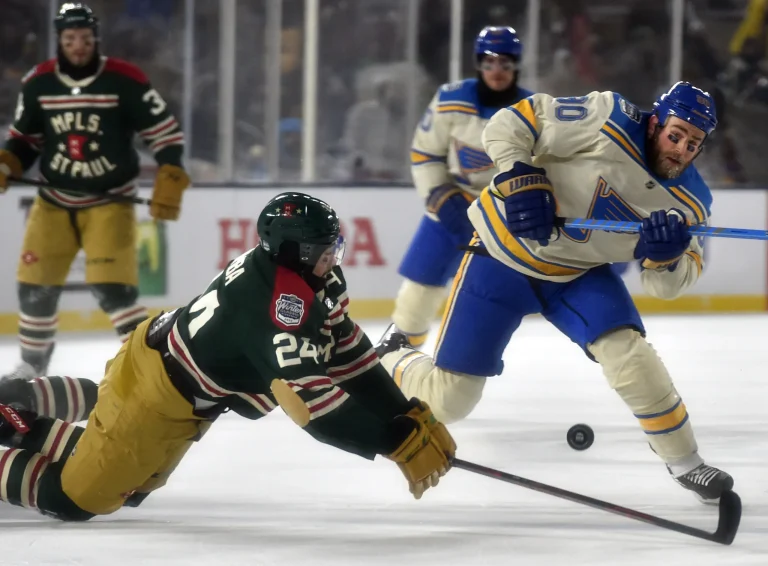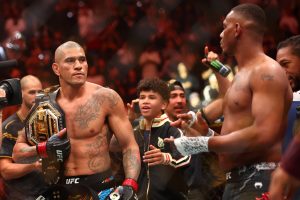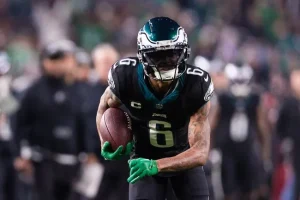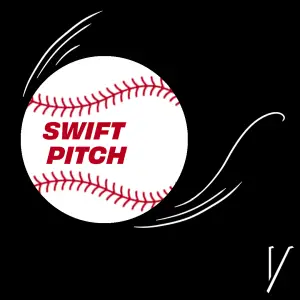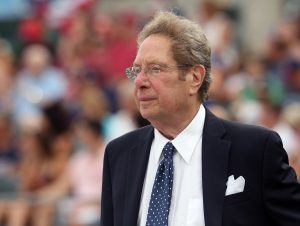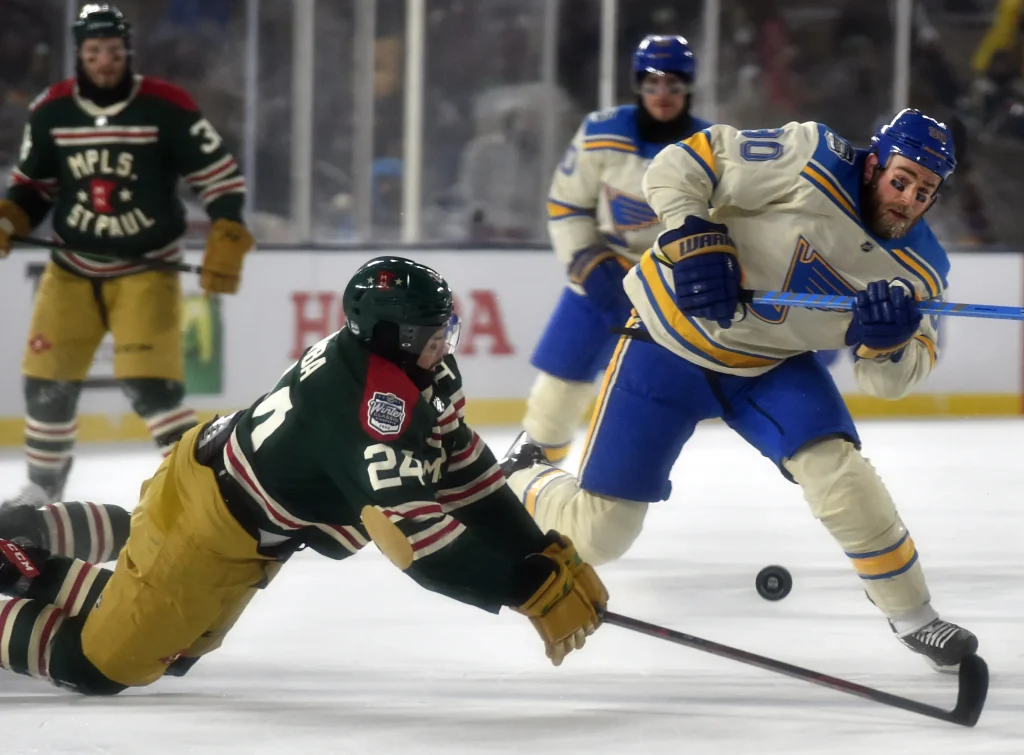
2022 Stanley Cup Playoffs Round 1 Preview: Wild vs. Blues
Five months ago, the Wild and Blues met on the regular season’s biggest stage — the Winter Classic. The Blues won handedly, but did so against a Wild team severely depleted due to COVID-19 and injuries. But even accounting for Minnesota’s unfamiliar roster for that big game, the Wild and Blues are very familiar with each other. They’ve been division rivals since the NHL’s realignment in 2013-14, including in the COVID-shortened, exclusively divisional 2021 season. They’ve met in the playoffs twice in that span, and played plenty of regular season games with a playoff level of physicality and nastiness. Both shared the status of “close but not quite” in the playoffs until the Blues broke through in 2019, right around the time when the Wild looked like their contending window was closing.
That obviously isn’t the case, at least not yet. Yes, Minnesota will have to worry about a near $13 million dead cap hit next season (and nearly $15 million for the next two years after) due to the Ryan Suter and Zach Parise buyouts last summer. St. Louis took looked like their best days were behind them after losing Alex Pietrangelo in 2020 and sleep-walking through most of 2021, only to be in for a rude awakening in a non-competitive first round series against the Avalanche team that likely awaits the winner of this series. Competitiveness shouldn’t be an issue in this matchup, which features two of the hottest teams to finish the regular season. That’s usually a strong indicator of playoff success. But it will only be the case for one of them this season.
Minnesota Wild vs. St. Louis Blues
Recent History: This is the third playoff meeting between the two teams since 2015. The previous two were both first-round meetings that saw the lower seed advance; Minnesota in six in 2015, St. Louis in five in 2017. The Blues’ goaltending (Jake Allen was the starter for both series) played a major role in both matchups.
The Last Time Here: Both teams were bounced in the first round of the one-off West Division last year. The Blues were utterly overwhelmed by the Avalanche in a convincing Round 1 sweep. Minnesota more than held its own against a star-studded Golden Knights team. But Vegas proved too much to overcome, as the Wild lost their first game seven in franchise history.
Season Series: The Blues took all three meetings, though all were decided by less than two goals and two went to overtime. Minnesota drove play in the first two meetings, although St. Louis dominated the third contest, so maybe they figured something out they can exploit in the playoffs. It’s also worth noting the Blues are a dominant 13-1-2 against Minnesota since Craig Berube took over in Nov. 2018.
Minnesota Wins Because: They’ve acquired a franchise changing player each of the last two seasons. Maybe. Yes, they technically drafted Kirill Kaprizov in 2015. But he didn’t start to make his mark in Minnesota until he left the KHL in 2020. Kaprizov hasn’t just been a franchise-talent; he’s fundamentally changed the way the Wild played, and the way they are viewed. Even the best Minnesota teams of the mid-2010s won because of depth and defense; commendable, but not very exciting. That’s changed since Kaprizov arrived.
| Years | Goals/Game | Shots/Game | Expected Goals/60 Min. (5v5) | PP Exp. Goals/60 |
| 2012-13 — 2017-18 | 2.77 (16th) | 29.4 (25th) | 2.14 (25th)* | 7.11 (12th) |
| 2018-19 — 2019-20 | 2.83 (22nd) | 30.8 (T-21st) | 2.32 (23rd) | 5.81 (T-27th) |
| 2020-21 — 2021-22 | 3.51 (4th) | 30.8 (T-12th) | 2.36 (16th) | 6.17 (24nd) |
While it’s interesting that Kaprizov’s impact doesn’t show up more in the underlying numbers, especially on the power-play (although it’s still obvious to anyone who’s watched the Wild), he’s undoubtedly helped make his teammates much better as well. Players like Kevin Fiala and Mats Zuccarello have both an elite teammate to work with when they’re playing with Kaprizov (which Fiala rarely does at 5-on-5) or benefit from facing lesser competition if they’re separated. Kaprizov is so good that Joel Eriksson Ek, who most would consider Minnesota’s most talented center, almost never plays with him at 5-on-5 (only about 12% of their minutes are together).
This truly is a team-wide surge. Perhaps the biggest evidence of that is that it’s turned journeymen bottom-sixers like Marcus Foligno (who was unfortunately injured, though not severely enough to keep him out of the lineup, in Minnesota’s final regular season game), Frédérick Gaudreau, and Ryan Hartman into key contributors. Hartman, a six-year veteran, has over a third of his career goals this season. Gaudreau had just 18 points in 103 career games before exploding for 42 this year. Only Foligno’s rise is attributable to a massive shooting percentage spike, and he’s now sustained a 25% or so shooting percentage over two seasons.
After being perhaps the biggest extreme of quality over quantity last year (29th in Corsi, 13th in Expected Goals%), the Wild have become a much more well-rounded team, finishing 11th in Corsi and 6th in Expected Goals share. Minnesota is sixth in the NHL at creating chances off the rush, an area where Kaprizov’s elite ability to carry and transition the puck shines the brightest.
This is also where Minnesota’s well-rounded, puck-moving backend shines as well. The Wild excel at retrieving the puck and breaking out of their own zone. Out of seven defensemen to play at least 35 games for Minnesota, all except for Jordie Benn are above average in successful zone exits & retrievals per 60 minutes. No team succeeds on a higher percentage of their breakouts than the Wild. Next closest are Nashville and Winnipeg, who are 2.4% behind. For reference, that’s the same as the gap between the Predators and Jets and the Blues, who rank ninth. The Blues have some strong puck-movers on their blue-line, but few backends are as well rounded as Minnesota’s.
One area where the Wild are a bit susceptible is entries; Minnesota yields the sixth highest carry against percentage on zone entries in the league. Minnesota’s strength comes from suppressing chances once teams do get set-up. It should create a fascinating battle as some of the younger, highly skilled Blues forwards try to turn Minnesota’s looseness at their own blue-line into a barrage of scoring chances.
If they’re successful, it could create a similar environment to what Marc-André Fleury, the second potentially franchise changing talent, was in at the start of the season in Chicago. Fleury got off to a very poor start in the Windy City, finishing October with a .872 save percentage. While part of that was due to a poor Blackhawks defense, it was worth wondering if Fleury was near the end of the line. However, from November to January, Fleury looked the like Vezina Trophy winner he was last season, finishing tied for fifth in the NHL in save percentage over that time. He’s been very inconsistent since coming to Minnesota, with three games under an .840 save percentage but a solid .911 mark on the whole.
Fleury will likely (probably?) begin the playoffs as Minnesota’s starter. But it’s worth noting since the trade, Cam Talbot has played exactly as many games as Fleury with a slightly higher save percentage. With another year of a slightly condensed playoff schedule, it’ll be interesting to see if Dean Evason applies the same approach Peter DeBoer did last year, giving the now 37-year old Fleury the occasional day off either at the start of the series or on part of a back-to-back. The former should only be an issue moving forward, though.
St. Louis Wins Because: Their depth up front is almost impossible to match, and we’ve seen this movie in net before. Ten Blues players have at least 45 points this year, a mark that no one, not even the shooting-the-lights-out Panthers can touch (Florida is second with eight). Two of those players have missed at least ten games and a third, Torey Krug, might be in that category if he hadn’t missed 20 games. Whether they’re stacking their top-nine and top-four or spreading the wealth, St. Louis is an incredibly difficult team to shut down, even for a strong defense like Minnesota’s.
But it’s not just all about depth; high-end talent is all but a prerequisite to win hardware. St. Louis has that, too. Every Stanley Cup champion of the post-2013 lockout era has had at least one go-to, dynamite goal scorer, with only the 2013-14 Kings serving as a possible extension. Vladimir Tarasenko was St. Louis’ lethal weapon when they won it all, and after two seasons marred by injuries and frustration, Tarasenko is back on that level.
After shooting just 6% last year, Tarasenko has enjoyed an exciting renaissance this year, setting a career-high in points. While the Blues do a lot of their damage on the PP (which I’ll get to later), Tarasenko is actually third in the NHL in 5-on-5 goals per 60 minutes, trailing only Auston Matthews and Filip Forsberg. There’s a bit of luck in that; Tarasenko is scoring 1.64 goals per 60 on just 0.96 expected. But some of that can be chalked up to Tarasenko’s shooting talent, as he’s reminded everyone just how fearsome of a goal-scorer he is at peak powers.
It helps having two fearsome talents next to him, including one of the league’s most underrated playmakers in Robert Thomas. He’s had almost as big of a turn-around as Tarasenko. In his first three seasons (169 games), Thomas had 85 points. In 75 games this year, he’s had 77 points, including 55 assists. Thomas trails only Jordan Kyrou on the Blues in controlled entries per 60 minutes and is sixth in the entire league at turning those entries into scoring chances. He’s nearly lapping the field in high-danger shot assists per 60 minutes, averaging nearly 1.5 more than second place Sonny Milano. Tarasenko’s benefit from this is obvious; he averages a jaw-dropping 4.7 shots off high-danger passes, nearly double any other player. Only one offensive duo averages more chances for and chances set-up than Tarasenko and Thomas: Toronto stars Auston Matthews and Mitch Marner.
There’s plenty of talent behind them, though, although most aren’t as dynamic. The one exception to that is Pavel Buchnevich, a deal that has made Rangers fans painfully aware of how bad Senators fans must have felt about the Mika Zibanejad-Derick Brassard trade. Buchnevich is a nice happy-medium between the pure sniper Tarasenko and pure playmaker Thomas. Only Kyrou creates more off the rush than Buchnevich. But he’s also very effective on the cycle and one of the team’s best forecheckers. He’s averaging almost an extra shot per 60 minutes than his previous career-high, set last season. Perhaps he’s a bit fortunate to reach 30 goals; he’s only accounting for 0.94 individual expected goals per 60, a 21-goal pace given his ice-time. But even accounting for that, he’s still a tremendous offensive player.
A lot has been made of the Blues’ dependency on special teams, and there certainly is some truth to that. No power-play in the league creates more high-danger shot assists per 60 minutes than the Blues, who had nine players reach double figures in PP scoring. Their man advantage could suffer if Torey Krug, their PP1 quarterback, is sidelined or hampered by the upper-body injury that’s forced him to miss a couple of games down the stretch.
A lot has been made of the Blues’ 5-on-5 struggles, and with good reason. But they’ve actually done a solid job (basically as good as the Wild) at controlling the neutral zone. They simply just don’t generate enough shots on their entries, ranking just 29th in 5-on-5 shot attempts per 60. That’s a stark contrast to the Wild, who fire at will and are top-ten at creating chances off of rebounds.
Because of that, the Blues’ odds in this series probably come down to how much you trust Ville Husso. It’s always risky coming into the playoffs with a goaltender with minimal starting experience, let alone playoff history. Then again, that’s exactly what the Blues had in Jordan Binnington in 2019, and it worked out incredibly well for them. It’s a bit easier to have faith given Husso‘s been pretty consistent since earning a larger share of the starts in January, bouncing back from a down March (.898 SV%) in April.
This isn’t someone who’s being propped up by strong defense, either; Husso’s 15 goals saved above expected are the 9th most in the NHL. Like Talbot in Minnesota, Binnington is a better Plan B than most teams have. He could help Husso handle the pressure of the playoffs given just how similar of a scenario he mastered. Assuming Husso starts, of course.
Players to Watch:
MIN: Jared Spurgeon might be one of the most underrated defensemen in the NHL. He’s been that for a few years, and there was maybe some hope that would change when he replaced Mikko Koivu as captain in 2021. Or this season, when he passed Nick Schultz for most games played by a defenseman in Wild history. His recognition hasn’t really improved much since, but it’s not because his play has dropped off. He remains both a strong playmaker and defensive presence on Minnesota’s aforementioned backend. He’s very strong at retrieving the puck and even better at breaking out the puck when he does. Against a Blues team equipped to play both chip-and-chase and carry-in hockey, Spurgeon’s versatility makes him a vital part of the Wild’s chances. He can also defend the blue-line well, which is something that the Wild as a team somewhat struggle at.
Part of the reason why Spurgeon perhaps hasn’t received the recognition he deserves was the presence of Ryan Suter, a well-respected and well-known veteran who was still a good player when his Wild career ended after last year’s playoffs. Another piece of it is that the Wild haven’t advanced past the first round since 2015. And while he isn’t the flashiest player, Spurgeon is having the best offensive season of his career, on the cusp of a career-high in points despite missing about fifteen games. This year isn’t just a chance for the Wild to go all-in because of their impending salary cap doom; it could also be Spurgeon’s coming out party as one of the game’s best blue-liners.
STL: Of the 65 players to score at least 100 points combined over the last two seasons, none averaged fewer ice-time per game (15:36) than Jordan Kyrou. This season, 107 players have at least 15 power-play points. Guess who has the fewest power-play minutes per game among those players? You guessed it: Kyrou, at just 1:55. He’s the only player under two minutes, in fact. But among players with at least 50 PP minutes, he’s 25th with 7.07 points per 60.
The Blues have plenty of established scorers up front — Vladimir Tarasenko, Ryan O’Reilly, and Pavel Buchnevich. Kyrou and Robert Thomas’s breakouts have occurred so simultaneously they’ve sort of distracted the public from each other. Thomas gets a little more love given he’s spent a lot of time on the top line, whereas Kyrou has helped lock down St. Louis’ middle-six. While the Blues have plenty of good forwards behind their top line, Kyrou is one of the most skilled and creative. O’Reilly and David Perron are more successful at contributing on the forecheck. And O’Reilly is obviously one of the game’s most dominant two-way forwards. That makes Kyrou a bit of a unique commodity in the middle of the Blues’ forward core. Kyrou’s a candidate to move up if things get hairy. But he’s still more than a capable contributor even in his current third-line role.
The Pick: Only one other team (the Rangers) had a worse expected goals percentage than the Blues’ 47.19%. And unlike New York, the Blues haven’t significantly improved post deadline, despite adding Nick Leddy for a pretty steep price. They certainly have a formidable forward core. And their power-play has the potential to go off against an unspectacular Minnesota penalty kill. Ville Husso certainly presents an intriguing, potentially series-stealing threat in net. The Wild certainly know the peril a hot Blues goaltender can bring; arguably the strongest team in franchise history (2016-17) flamed out at the hands of a near unbeatable Jake Allen.
However, the Wild are a team that is in great position to handle St. Louis’s strengths and attack their weaknesses, at least at 5-on-5. The Blues’ biggest weakness is their back-end, and shutting down not just Kirill Kaprizov, but other electric talents like Zuccarello, Fiala, and Matthew Boldy, as well as Minnesota’s depth, is a daunting challenge. The Wild also have depth on the backend, with three strong pairs that can move the puck and have plenty of experience as well. The Blues may have enough talent to push the Wild to the breaking point. But I don’t think they’ll be able to phase them. Wild in 7.
Oddly Specific Prediction: This is an idea I always borrow from one of the best hockey writers, The Athletic’s Sean McIndoe (aka Down Goes Brown). The idea is very self-explanatory: make a very specific and semi-random prediction for each series. The idea is his; the predictions are mine. With all the focus on Kaprizov, Fleury, and the Blues’ forward core, the series winning goal is going to be scored by a defenseman.
Follow Us on Twitter! Also, check out the Vendetta Shop and our partnership with SimBull (learn more here)!
All Advanced Stats are 5-on-5 unless otherwise stated and via Natural Stat Trick, Corey Sznajder’s All Three Zones (subscribe to his Patreon here) and Moneypuck.com
Vendetta Sports Media is sponsored by Monkey Knife Fight, the fastest-growing DFS site in the industry. MKF’s unique style and gameplay make betting fun and easy. Use our promo code ‘VENDETTA’ or use the link below to get a 100% instant match on any deposit and let them know that we sent you!

